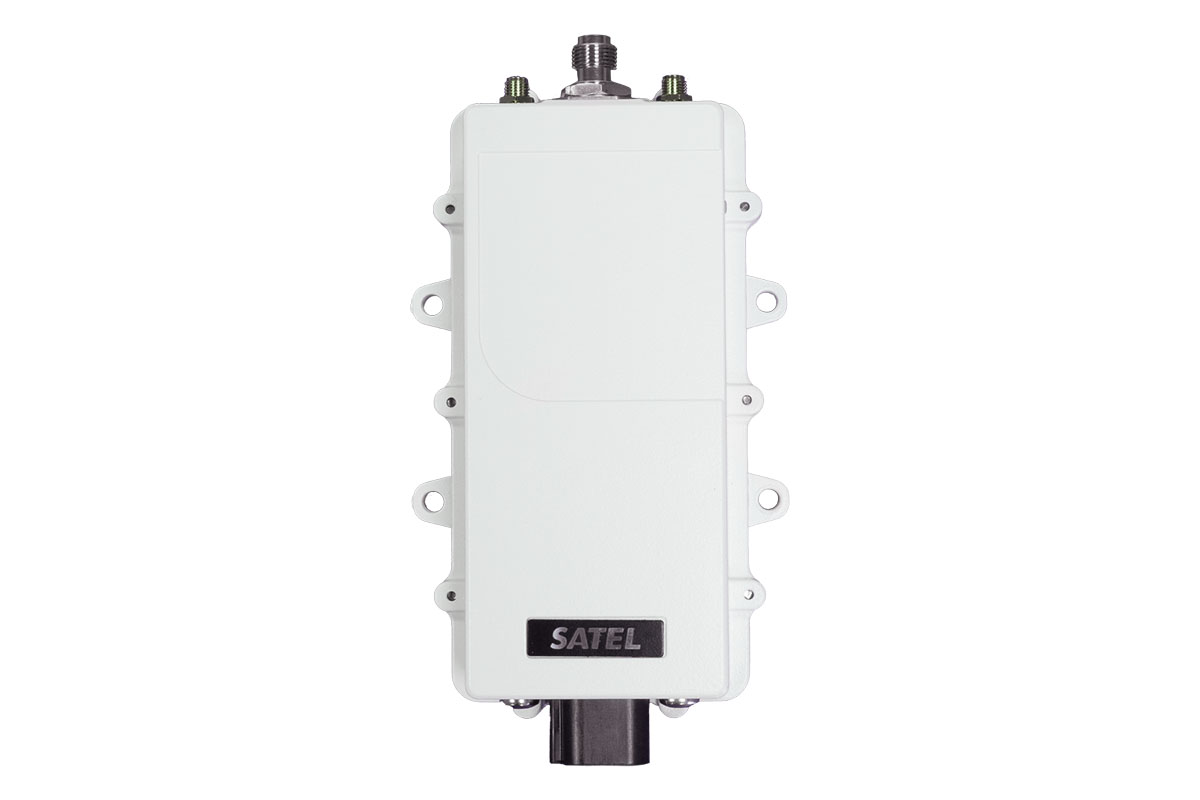SATEL MCCU-20 LTE / UHF
SATEL MCCU-20 LTE / UHF is an IP69K dual-technology RTK transceiver that utilizes UHF and NTRIP over LTE to receive GNSS RTK correction data efficiently to a moving vehicle. The RTK correction data is forwarded over RS-232 serial communication to machine control system.

The MCCU (Mission-Critical Connectivity Unit) platform is designed to resolve connectivity challenges in harsh environments. It delivers mission-critical signaling from relatively small machine control messages with constant latency to wideband and low latency camera stream.
SATEL MCCU-20 LTE / UHF has IP67 and IP69K classification and it withstands vibration and shock. It is based on field proven mechanics, and all the electrical connections are equipped with surge and ESD (Electrostatic Discharge) protection.
Machine, vehicle manufacturers and machine control system providers can integrate SATEL MCCU-20 LTE / UHF to their offering without knowing what kind of technology is available in the operating area. The vehicle can be operated under varying connectivity environments.
Mission-critical connectivity:
- RTK correction signaling for centimeter level positioning accuracy
- Collision avoidance signaling (CAS)
- Machine to machine commands (V2V also V2X)
- Secure firmware updates
- Central control signal
- Safety signaling
- Mission-critical telematics
Type approvals for main markets are to be carried out.
| Two communication modules | LTE: (NTRIP application, NMEA position upstream) UHF: 410 …475 / 902 … 928 MHz radio (RTK Receiver) |
| Serial interface | RS-232 (TD, RD lines) |
| Serial data speed | 4800 – 460800 bps |
| Operating voltage | +9 … +30 VDC (-15% / +20% ) |
| Operating temperature | –30°C to +70°C (operational) |
| Interface connector | Deutsch DT04-6P-CL09 |
| Antenna connector | 50 Ohm, 2 x SMA (LTE) / 1 x TNC (UHF) |
| Power consumption | Typ. 2.4 W (NTRIP receive) / Typ. <1 W (RTK receive) |
| Housing | Shielded / bare PCB inside a metal housing |
| Size / Weight | 174 mm x 95 mm x 47 mm / 520 g |
| IP classification | IP67 / IP69K |
| Cellular bands | GSM: B2/B3/B5/B8 WCDMA: B1/B2/B4/B5/B6/B8/B19 LTE-FDD: B1/B2/B3/B4/B5/B7/B8/B12/B13/B18/B19/B20/B26/B28 LTE-TDD: B38/B39/B40/B41 |
In the EU the product falls under the scope of the radio equipment directive
2014/53/EU (RED). In the USA and Canada, the relevant FCC / ISED parts are fulfilled.
| Free fall | ISO 16750-3:2012 IEC 60068-2-31:2008 |
| Mechanical shock (half sine) | ISO 16750-3:2012 IEC 60068-2-27:2008 |
| Vibration (random) | ISO 16750-3:2012 IEC 60068-2-64:2008 |
| Ingress Protection | IPX9K IEC 20653:2013 IP67 IEC 60529:2013 |
| Safety | IEC 62368-1:2018 Edition 3.0 |
| EMC | EN 301 489-1 v.2.2.3, -3 v.2.1.1, EN 301 489-52 v1.2.1, -19 v2.1.1 EN 55035:2017 + A11:2020 |
| Radiated emissions | EN 55032:2015 + A11:2020 |
| Electrostatic discharge | IEC 61000-4-2 Level 4: 4 kV contact, 8 kV air discharge |
| Radiated filed immunity | IEC 61000-4-3 (2010-04) IEC 61000-4-3:2020 Level 20 V/m |
| Polarity | Reverse polarity protection |
| Temperature and humidity (cyclic) | ISO 16750-4:2006 IEC 60068-2-38:2009 |
Integrated global roaming eSIM and traditional SIM card slot for local operator’s subscription.